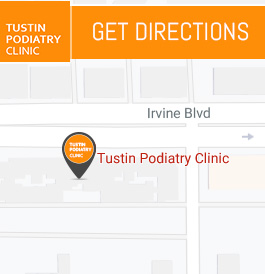Can You Go to a Podiatrist for Heel Spur Treatment?
Yes, you can go to a podiatrist for heel spur treatment. At Tustin Podiatry Clinic, Dr. Charles Baik, DPM, specializes in diagnosing and treating heel spurs with advanced and effective methods. Dr. Baik provides personalized treatment plans to alleviate pain and improve mobility, ensuring you receive the highest quality of care. For more information, contact us today or schedule an appointment online. We are conveniently located at 17400 Irvine Blvd. Suite H, Tustin, CA 92780.


Table of Contents:
What are heel spurs?
What deficiencies cause heel spurs?
What are the symptoms of heel spurs?
What triggers heel spurs?
Do heel spurs go away without surgery?
What happens if a heel spur goes untreated?
Heel spurs are bony growths that emerge on the calcaneus, the heel bone that bears the brunt of our daily weight. These growths can arise from prolonged stress placed on the heel, whether from rigorous activities like running and jumping or mundane tasks like standing for extended periods of time. Footwear woes, especially ill-fitting shoes and those voids of proper arch support, can also entice the formation of heel spurs.
Heel spurs are not always accompanied by the dreaded pain, which can range from mild discomfort to throbbing agony. Only when symptoms arise, often upon walking or standing, do these bony excrescences make their presence known.
While they’re not directly linked to a specific deficiency, there are certain factors that can set the stage for their development:
• Calcium Deficiency: Calcium is a bone-building block, so low levels can weaken your bones, making them susceptible to spurs.
• Vitamin D Deficiency: This vitamin aids in calcium absorption. When levels are low, your bones can be affected, raising the risk of heel spurs.
• Extra Weight: Carrying excess weight puts pressure on your feet, boosting the chances of developing heel spurs.
• Diabetes: This condition can alter blood sugar levels, impacting circulation and bone health, potentially contributing to heel spur formation.
• Unsupportive Shoes: Footwear that’s not a good match for your feet can lead to excessive strain on your heels, paving the way for heel spurs.
• Overexertion: Activities that put a lot of stress on your feet, like running or standing for long durations, can also increase the risk.
These are not the only causes of heel spurs, but they’reimportant factors to consider.
Heel spurs, those stealthy bony growths on the base of your heel bone, can manifest with a range of subtle yet impactful symptoms. Here’s a guide to help you recognize the telltale signs:
• Heel Pain: A piercing pain lurks where the heel meets the arch, intensifying upon awakening or post-prolonged sitting. Prolonged ambulation or standing exacerbates this discomfort.
• Tenderness: The sole’s contact with the ground becomes an ordeal, leaving a lingering soreness and tenderness beneath the heel.
• Swelling: Your heel swells, signaling the onset of an inflammatory response, often accompanied by a reddish hue.
• Stiffness: Your heel stiffens, particularly after a night’s slumber, limiting its range of motion.
• Bony Bump: Upon careful inspection, a small, bony protrusion emerges on the heel’s underside, hinting at the presence of a heel spur.
If you experience any or all these symptoms, seek medical attention promptly. A timely diagnosis and personalized treatment plan will empower you to alleviate the discomfort and restore heel harmony.
Heel spurs form due to repeated stress and strain on your foot. Here is an overview of the common triggers:
• Repetitive Stress: Engage in high-impact activities like running or jumping excessively, and your heel takes the brunt of it.
• Poorly Supportive Shoes: Don’t neglect proper footwear support. Wearing shoes that don’t properly support your feet can lead to plantar fasciitis and heel spurs.
• Age: Aging brings wear and tear to our bodies, weakening our feet and increasing spur risk.
• Weight: Excess pounds pile on pressure, increasing your risk of heel spurs.
In most cases, they don’t vanish on their own, but you can tame the agony without resorting to the operating table. Here are some options that offer pain relief:
• Rest: Give your heels a rest from activities that cause pain. Allow them to relax and recover.
• Icing: Cool down your heel with ice for 15-20 minutes. It’s like a soothing balm for pain and swelling.
• Pain-Killers: Over-the-counter ibuprofen or acetaminophen can lend a helping hand in easing the discomfort.
• Shoe Support: Slip into shoes that cradle your feet with support and cushioning. Reduce the weight on your heel with these comfy companions.
• Stretching: Unleash the power of gentle stretching for your feet and calves. These exercises can ease pain and bring relief.
• Injections: If all else fails, your doctor might enlist the help of corticosteroid injections to shut down inflammation and soothe the pain.
These steps can be your secret in managing the pain of heel spurs. Heel pain can often be remedied without surgery, but if the pain persists and these remedies don’tprovide relief, seek medical advice. While heel spurs rarely disappear on their own, proper care can dramatically reduce the discomfort.
Leaving a heel spur untreated can lead to a number of different issues, making daily tasks daunting. Here’s a list of symptoms you could experience if a heel spur is left untreated:
• Severe Pain: The heel spur incites soreness and inflammation in surrounding tissues, creating discomfort. Walking or standing can intensify the pain, potentially causing it to worsen over time.
• Stiffness: Inflammation can cause your heel and ankle to stiffen, limiting foot mobility.
• Swelling: Persistent inflammation can shroud your heel in a swelling that impedes movement.
• Numbness: Pressure from the heel spur on nerves can cause numbness or tingling in the heel or toes.
If heel pain persists, it’s imperative to consult with a medical professional. Prompt treatment can alleviate symptoms and prevent the condition from worsening. Seek help before the heel spur starts affecting your daily life at Tustin Podiatry Clinic. We serve patients from Tustin CA, Irvine CA, Garden Grove CA, Orange CA, Anaheim CA, Costa Mesa CA, Lake Forest CA and BEYOND!

Additional Services You May Need
▸ Heel Pain Treatment
▸ Laser Fungal Nail Treatment
▸ Ingrown Toenail Treatment
▸ Ankle Sprain Treatment
▸ Foot and Ankle Medicine & Surgery
▸ Orthotics Custom
▸ EPAT/Shockwave Therapy
▸ Hammertoe
▸ Arthritis Treatment
▸ Diabetic Foot Care
▸ Flat Feet Treatment
▸ Foot Warts Treatment
▸ ClarixFlo





